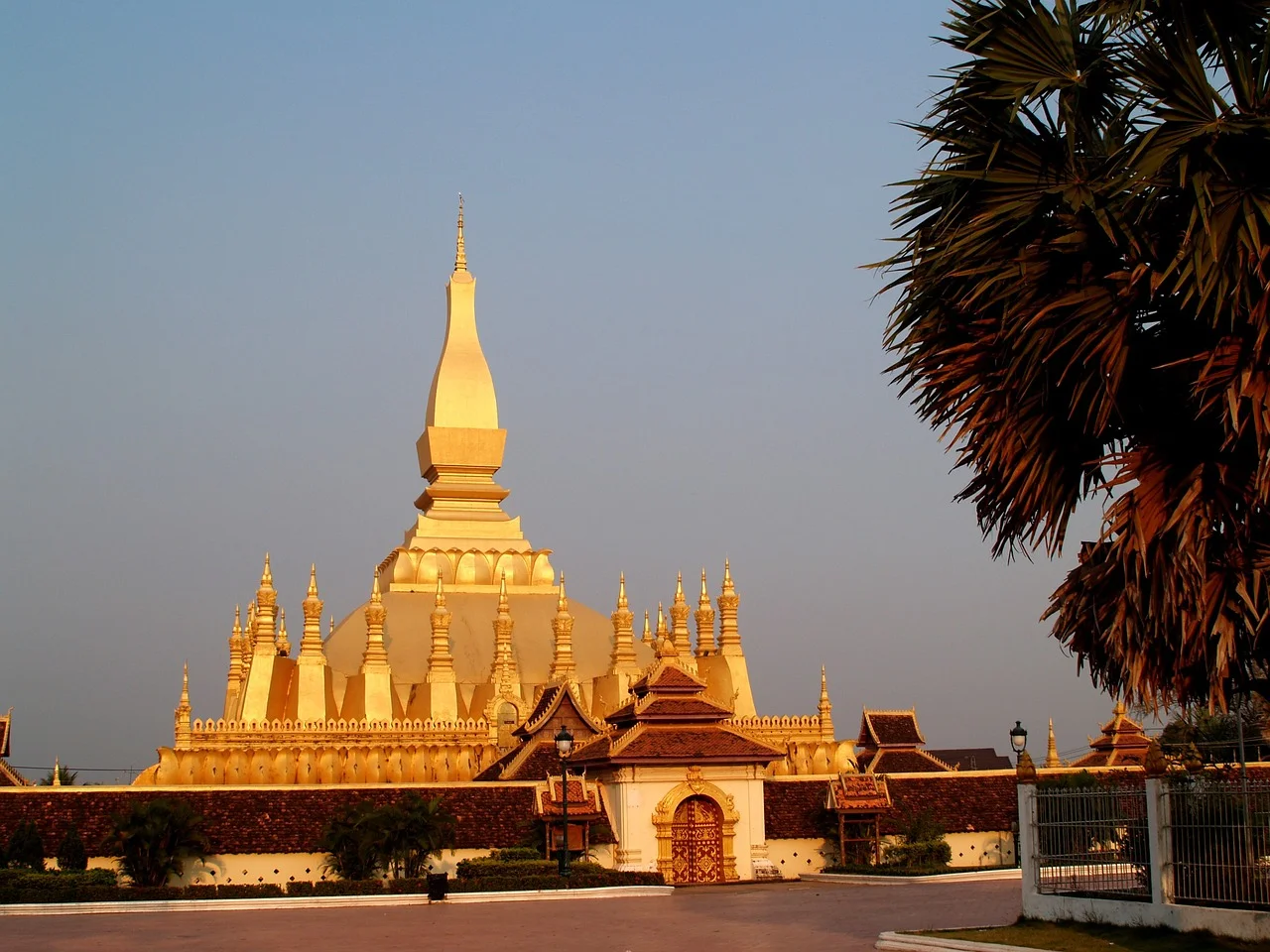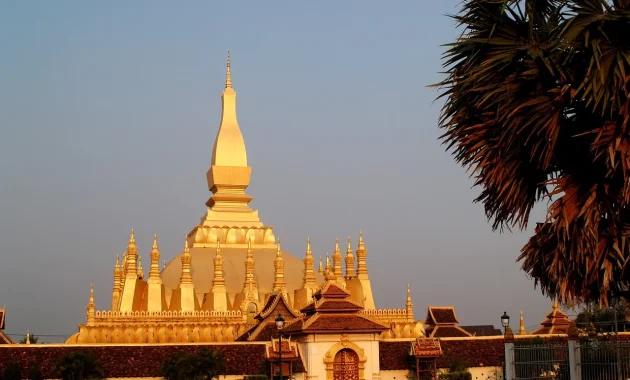
Nestled in the heart of Vientiane, the capital of Laos, stands the awe-inspiring Pha That Luang. This towering golden stupa is more than just a historical monument; it is a symbol of Laos’ spiritual essence and a testament to its rich cultural heritage. The importance of Pha That Luang extends far beyond its architectural brilliance, embodying the nation’s Buddhist faith and national pride.
The Historical Significance of Pha That Luang
Pha That Luang, or the “Great Stupa,” dates back to the 3rd century when, according to ancient records, a stupa was first erected to enshrine a piece of Buddha’s breastbone. Over the centuries, the structure underwent numerous restorations, especially after invasions and wars left it in ruins. The most significant restoration came during the 16th century under the rule of King Setthathirat, when it was rebuilt to reflect its present grandeur.
The stupa is said to have been inspired by Indian Buddhist architecture, but its current form is distinctly Lao, making it an extraordinary fusion of cultural influences. The temple complex, which has seen successive kings and dynasties contribute to its beauty and expansion, stands as a beacon of Laos’ resilience and devotion to Buddhism.
Architectural Masterpiece: The Design of Pha That Luang
The imposing structure of Pha That Luang rises to a height of 45 meters, covered in a gleaming layer of gold leaf, symbolizing the purity and sanctity of the Buddhist religion. The stupa itself is surrounded by three levels, each representing a different aspect of Buddhist philosophy. The lowest level symbolizes the material world, the middle level represents the 17 stages of Buddhist enlightenment, and the uppermost level represents the kingdom of heaven.
The temple complex is not just the main stupa but also includes smaller stupas, shrines, and temples that are equally adorned in golden hues. Each architectural element tells a story, with intricate carvings depicting scenes from the life of Buddha. The surrounding gardens and walls are adorned with Buddhist motifs, further emphasizing the religious significance of the site.
Visitors walking through the gates of Pha That Luang are greeted by the sight of monks in saffron robes, performing rituals and chants. These everyday religious practices breathe life into the ancient structure, making it not just a relic of the past but an active center of Buddhist worship.
Cultural and Religious Importance
At its core, Pha That Luang is a profound religious symbol. The stupa is the heart of Buddhism in Laos and has long been associated with the spiritual identity of the Lao people. Every year, the site is the center of the That Luang Festival, a religious event that draws thousands of pilgrims from across the country and beyond. The festival, celebrated in November, includes a series of Buddhist rituals, processions, and cultural performances, making it one of the most important religious events in Laos.
The That Luang Festival not only marks a time for religious devotion but also serves as a reminder of Laos’ national unity. During the festival, people from various ethnic backgrounds and social classes come together in reverence, reflecting the deep cultural ties that the monument holds.

Pha That Luang as a National Symbol
In addition to its religious significance, Pha That Luang is a symbol of national pride for Laos. It is featured prominently in the Laotian national emblem, representing the country’s sovereignty and Buddhist heritage. The stupa’s golden spire is a visual representation of the nation’s aspirations and its unwavering devotion to peace and prosperity.
Throughout its history, Pha That Luang has witnessed the ebb and flow of political and cultural change. From periods of foreign domination to times of independence, the stupa has remained a steadfast emblem of Lao identity. Its survival through wars and invasions stands as a testament to the resilience and determination of the Lao people.
The government of Laos recognizes Pha That Luang as a national treasure, and it has been meticulously preserved and protected as part of the country’s rich cultural heritage. The stupa is also a symbol of the Laotian monarchy, with several kings historically associated with its construction and restoration. This strong connection between Pha That Luang and the leadership of the nation only enhances its standing as a monument of national unity.
Visitor Experience: Discovering Pha That Luang
For travelers and pilgrims alike, visiting Pha That Luang is a deeply moving experience. The majestic stupa, bathed in sunlight, radiates a sense of serenity and spiritual significance that is difficult to put into words. Walking around the stupa, visitors can observe the fine details in the craftsmanship of the golden exterior, as well as the sacred statuesthat adorn the site.
Tourists are encouraged to explore the inner courtyards, where smaller stupas and temples dedicated to various Buddhist deities offer a glimpse into the rich religious tapestry of Laos. The surrounding gardens and quiet atmosphere provide an ideal setting for reflection and meditation, allowing visitors to connect with the spiritual energy of the place.
Additionally, the Pha That Luang Museum offers an insightful look into the history of the site, with artifacts and displays that detail the various stages of its construction and renovation. The museum also showcases items from the That Luang Festival, providing a deeper understanding of its significance to the local community.
Best Time to Visit Pha That Luang
While Pha That Luang is a captivating site year-round, the best time to visit is during the That Luang Festival in November. The festival transforms the stupa into a bustling hub of activity, with devotees engaging in traditional ceremonies, chanting, and offerings. The colorful processions and festive atmosphere bring the monument to life, offering a unique opportunity to witness the deep connection between the Lao people and their Buddhist faith.
For those seeking a more tranquil experience, visiting outside of festival periods offers a peaceful atmosphere where the majesty of the stupa can be appreciated in quiet contemplation. Early mornings or late afternoons are ideal for avoiding the heat and enjoying the stupa bathed in the golden glow of sunrise or sunset.
Conclusion: A Monument of Spiritual and National Significance
Pha That Luang stands as an enduring symbol of Laos’ spiritual heart and its unbreakable connection to its Buddhist heritage. With its rich history, stunning architecture, and deep cultural importance, the stupa is not only a must-visit for travelers but also a powerful reminder of the national pride and spiritual unity of the Lao people. Whether one visits for religious purposes or to admire its beauty, Pha That Luang leaves an indelible impression on all who experience it.